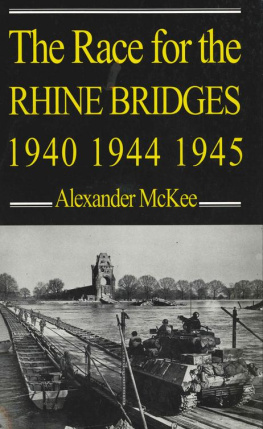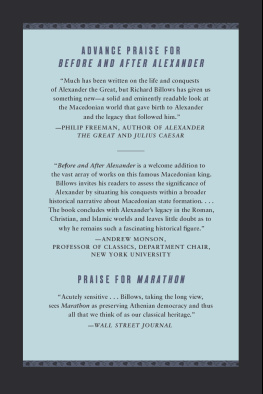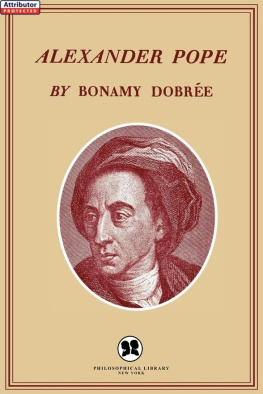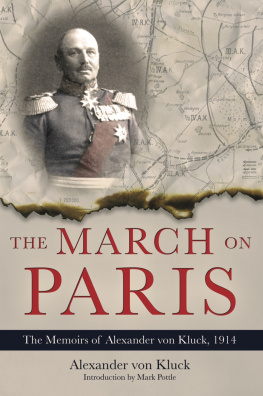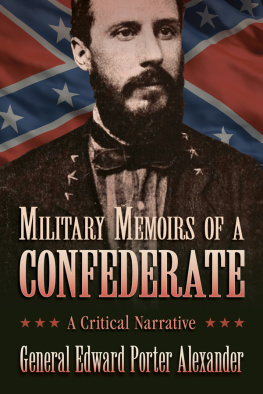


The Alexander Memoirs 19401945
This edition published in 2010 by Frontline Books, an imprint of
Pen and Sword Books Ltd., 47 Church Street, Barnsley,
S. Yorkshire, S70 2AS.
Visit us at www.frontline-books.com, email info@frontline-books.com
or write to us at the above address.
Copyright Harold Alexander, 1961
This edition Pen & Sword Books Ltd., 2010
Introduction copyright James Holland, 2010
The right of Harold Alexander, 1st Earl of Tunis to be identified
as the Author of this work has been asserted in accordance
with the Copyright, Designs, and Patents Act 1988.
9781844685417
PUBLISHING HISTORY
The Memoirs of Field-Marshal Earl Alexander of Tunis was published
by Cassell & Company Limited (London) in 1962. This edition includes a new
introduction by James Holland and a new foreword by Shane Alexander,
the son of the author. The plate section has been updated with previously
unpublished photographs, which were kindly supplied by the family.
All rights reserved.
No part of this publication may be reproduced, stored in or introduced
into a retrieval system, or transmitted, in any form, or by any means
(electronic, mechanical, photocopying, recording or otherwise) without
the prior written permission of the publisher. Any person who does
any unauthorized act in relation to this publication may be liable
to criminal prosecution and civil claims for damages.
CIP data records for this title are available from the British Library.
Typeset by M.A.T.S. Typesetters, Leigh-on-Sea, Essex
Printed in Great Britain by CPI Antony Rowe
ILLUSTRATIONS
between pages 106 and 107
NOTE FROM LORD ALEXANDER
Alex was supremely indifferent to having his photograph taken. Consequently there is a dearth of images of him commanding his troops in the North African and Italian campaigns. Instead some previously unpublished photographs of him taken not long after the war have been chosen by the publishers and are included in this book.
NOTE FROM THE PUBLISHER
The plate section of this edition of this edition of The Alexander Memoirs contains many photographs that were used in the original edition, which was published in 1962.
Plate 1 Alex with the King and Queen at an artillery demonstration in 1940; with Churchill and General Montgomery in North Africa, August 1942
Plate 2 Field Marshal Erwin Rommel; Alex with Field Marshal Smuts and Sir Miles Lampson in Cairo, October 1942.
Plate 3 Alex with General Dick McCreery; General Bernard Freyberg and General Brian Horrocks
Plate 4 An infantry platoon at Alamein; the guns of Alamein, 23 October 1942
Plate 5 Bruce Scott, Wise, Alexander, Wavell, Slim and Taffy Davies in Burma, 1942; Dunkirk harbour, June 1940
Plate 6 Prime Ministers conference in Algiers, June 1943; Alex with General Eisenhower
Plate 7 A Valentine Mk2 light infantry tank entering Tripoli in January 1943; Alex and Montgomery in Italy, November 1943
Plate 8 Alex with General Omar Bradley; General Vinegar Joe Stilwell
Plate 9 Coming ashore at Salerno with Mark Clark and Dick McCreery; Alex at a joint services parade in Tunis with Mark Clark and General Juin
Plate 10 With General John Harding, his loyal chief of staff; Generals Montgomery, Richardson, Alex, Bedell Smith and Patton in Sicily.
Plate 11 Alex driving Harold Macmillan around the ruins of the town of Cassino; with King George VI on one of his visits to the battlegrounds in the Liri Valley
Plate 12 With General Anders; Alex with Marshal Josef Tito on the terrace of the White Palace, Belgrade, 24 February 1945
Plate 13 A gaslit summit conference at the Foreign Office, Athens, 27 December 1944; final surrender in Italy, 12 noon, 2 May 1945
Plate 14 With Marshal Tolbukhin and Colonel-General Jeltof; Alexs mobile HQ at Lake Bolsena
Plate 15 Alex addressing his troops; at Buckingham Palace with the King celebrating the Irish Guards Golden Jubilee in June 1950
Plate 16 With the Queen and the Earl of Home at the Bowes Lyon family home, 1950s; inspecting German troops in Dsseldorf, 1964
PREFACE
Two years ago I returned to the battlefields of North Africa and Italy. I am glad to have undertaken this pilgrimage because I feel that a commander should file for the record the work of his armies in the field. In particular, I was concerned that the Allied campaign in Italy should receive due recognition in history for its contribution to the general victory in the west. Strategic considerations apart, the seemingly unending succession of mountain ranges, ravines, and rivers of the Italian terrain demanded the soldierly qualities of fighting valour and endurance in a measure unsurpassed in any other theatre of war.
Thus it came about that in the autumn of 1960 I left England for Cairo, by way of Athens, and thereafter followed the tank tracks of the British Eighth Army and of the Allied Armies, on the ground or from the air, across the Western Desert into Tunisia, and thence, by way of Malta and Sicily, the length of Italy to Trieste. I was accompanied by my two former Chiefs-of-Staff, Field-Marshal Lord Harding and General Sir Richard McCreery, afterwards to succeed to command of the famed Eighth Army, and by another friend, my collaborator, Major John North, who undertook the task of committing my thoughts to paper.
In the narrative that follows the reader will learn what reflections passed through my mind as I revisited those battle-grounds of the Mediterranean war which, although they have now passed into history, still vividly remain on the horizon of memory for the officers and men who fought over them.
WINKFIELD LODGE
WINDSOR FOREST, BERKSHIRE
FOREWORD
WHEN the author James Robinson wrote a book on my father shortly after the war, he sent a draft to him for comment. My father hardly glanced through the manuscript before replying, write whatever you wantits your book.
Alex never showed the slightest concern for his reputation preferring, in his memoirs, to concentrate on the military campaigns themselves rather than on the personalities of those involved in them. To this end he revisited the battlefields in North Africa before writing this book.
No one had a clearer vision of those campaigns in North Africa and Italy since it was he who had worked the long hours alone before presenting the plans to his commanders for the necessary briefings. The reader will see in the books later chapters that he gives full credit to General Anderson of First Army and General Montgomery of Eighth Army, both of whom so ably put his strategies into practice.
I well remember one or two occasions when my school friends, while visiting us at home, grasped any opportunity to ask my father about his experiences in the war, only to be met by a brief, light-hearted comment. He seldom dwelt on the subject (other than asking the boys if they were planning to do their National Service and in which regiments). His interest in the past wasnt great, and the many, many war books he had been given over the years lay unread in the library.







